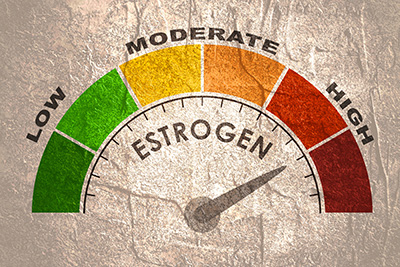
Estrogen dominance is a phrase used to describe what can happen when estrogen and progesterone get out of balance. It is a relative excess of estrogen - it doesn’t mean there is too much estrogen, but that there is too much estrogen relative to the level of progesterone. As a woman reaches the age of menopause, her body continues to produce estrogen in her muscle and fat cells. She may typically produce 40-60 percent of the estrogen made before menopause but only very little progesterone.
Over-stimulation from estrogen in the breast tissue can cause unpleasant symptoms and lead to health issues, for example, breast tenderness, swelling, and fibrocystic breasts. In the uterus, excess estrogen stimulation may lead to endometriosis, cervical dysplasia, increased risk of uterine cancer, heavy or irregular menses, menstrual cramping and uterine fibroid tumors. Excessive estrogen (dominance) can also cause weight gain, constipation, cyclical headaches and migraines, depression, mood swings, fluid retention, low libido, and anxiety.
Women can become estrogen-dominant for many reasons. Lack of exercise, impaired elimination of estrogen, not taking in enough dietary fiber, lack of adequate amounts of progesterone to balance estrogen, using birth control pills, and environmental exposure. Estrogen mimickers are everywhere in the environment in the form of chemicals (xenoestrogens), and foods and plants (phytoestrogens). Pesticides are perhaps the biggest source of xenoestrogens followed by plastics, fuels, drugs, cosmetics, nonorganic meats and some dairy products.
Call The Anti-Aging Center at Make You Well today for a comprehensive consultation at (424) 374-2800.